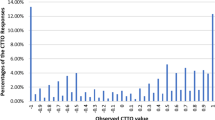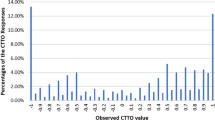Abstract
Purpose
This study aimed to estimate Korean preference weights for EQ-5D-5L based on values elicited from Korean population by applying the EuroQol Valuation Technology (EQ-VT) program and the standard protocol by the EuroQol Group.
Methods
The multistage quota sampling method was used to recruit 1085 subjects from the general population in Korea. Each respondent valuated 10 health states using the composite time trade-off (cTTO) and 7 health states using discrete choice experiment. The EQ-VT program was developed by the EuroQol Group and translated into Korean with the Korean research team. Computer-assisted, face-to-face interviews were conducted. A range of predictive models were explored using cTTO. The most appropriate model was determined after assessing goodness of fit, logical consistency, and parsimony.
Results
Of 3206 contacted, 1085 subjects completed interviews (33.8 %) and 1080 were used for modeling. A model with dummy variables for each level of severity and dimension and a term that picked up whether any dimension in the state was at level 4 or 5 was selected as the best predictive model. All coefficients of the final model were statistically significant and logically consistent. In addition, it was parsimonious. This model had mean absolute error of 0.027, and the absolute error for all 86 health states was below 0.1.
Conclusions
The final model built in this study appears to predict the utilities of the states which were valuated directly. This model could be used to interpolate quality weights for all EQ-5D-5L health states.

Similar content being viewed by others
References
Dolan, P., Gudex, C., Kind, P., & Williams, A. (1996). Valuing health states: A comparison of methods. Journal of Health Economics, 15(2), 209–231.
Torrance, G. W. (1986). Measurement of health state utilities for economic appraisal. Journal of Health Economics, 5(1), 1–30.
Torrance, G. W., Feeny, D. H., Furlong, W. J., Barr, R. D., Zhang, Y., & Wang, Q. (1996). Multiattribute utility function for a comprehensive health status classification system. Health Utilities Index Mark 2. Medical Care, 34(7), 702–722.
Feeny, D., Furlong, W., Torrance, G. W., Goldsmith, C. H., Zhu, Z., DePauw, S., et al. (2002). Multiattribute and single-attribute utility functions for the health utilities index mark 3 system. Medical Care, 40(2), 113–128.
Brazier, J., Roberts, J., & Deverill, M. (2002). The estimation of a preference-based measure of health from the SF-36. Journal of Health Economics, 21(2), 271–292.
Norman, R., Cronin, P., Viney, R., King, M., Street, D., & Ratcliffe, J. (2009). International comparisons in valuing EQ-5D health states: A review and analysis. Value in Health, 12(8), 1194–1200.
Jo, M. W., Yun, S. C., & Lee, S. I. (2008). Estimating quality weights for EQ-5D health states with the time trade-off method in South Korea. Value in Health, 11(7), 1186–1189.
Lee, Y. K., Nam, H. S., Chuang, L. H., Kim, K. Y., Yang, H. K., Kwon, I. S., et al. (2009). South Korean time trade-off values for EQ-5D health states: Modeling with observed values for 101 health states. Value in Health, 12(8), 1187–1193.
Herdman, M., Gudex, C., Lloyd, A., Janssen, M., Kind, P., Parkin, D., et al. (2011). Development and preliminary testing of the new five-level version of EQ-5D (EQ-5D-5L). Quality of Life Research, 20(10), 1727–1736.
Kim, S. H., Kim, H. J., Lee, S. I., & Jo, M. W. (2012). Comparing the psychometric properties of the EQ-5D-3L and EQ-5D-5L in cancer patients in Korea. Quality of Life Research, 21(6), 1065–1073.
Pickard, A. S., DeLeon, M. C., Kohlmann, T., Cella, D., & Rosenbloom, S. (2007). Psychometric comparison of the standard EQ-5D to a 5 level version in cancer patients. Medical Care, 45(3), 259–263.
Janssen, M. F., Birnie, E., Haagsma, J. A., & Bonsel, G. J. (2008). Comparing the standard EQ-5D three-level system with a five-level version. Value in Health, 11(2), 275–284.
van Reenen, M., & Janssen, B. (2015). EQ-5D-5L user guide basic information on how to use the EQ-5D-5L instrument version 2.1. http://www.euroqol.org/fileadmin/user_upload/Documenten/PDF/Folders_Flyers/EQ-5D-5L_UserGuide_2015.pdf
Oppe, M., Devlin, N. J., van Hout, B., Krabbe, P. F., & de Charro, F. (2014). A programme of methodological research to arrive at the new international EQ-5D-5L valuation protocol. Value in Health, 17(4), 445–453.
Devlin, N. J., Tsuchiya, A., Buckingham, K., & Tilling, C. (2011). A uniform Time Trade Off method for states better and worse than dead: Feasibility study of the ‘lead time’ approach. Health Economics, 20(3), 348–361.
Ramos-Goni, J. M., Pinto-Prades, J. L., Oppe, M., Cabases, J. M., Serrano-Aguilar, P., & Rivero-Arias, O. (2014). Valuation and modeling of EQ-5D-5L health states using a hybrid approach. Medical Care. doi:10.1097/MLR.0000000000000283.
Badia, X., Roset, M., & Herdman, M. (1999). Inconsistent responses in three preference-elicitation methods for health states. Social Science and Medicine, 49(7), 943–950.
Tsuchiya, A., Ikeda, S., Ikegami, N., Nishimura, S., Sakai, I., Fukuda, T., et al. (2002). Estimating an EQ-5D population value set: The case of Japan. Health Economics, 11(4), 341–353.
Dolan, P. (1997). Modeling valuations for EuroQol health states. Medical Care, 35(11), 1095–1108.
Wittrup-Jensen, K. U., Lauridsen, J., & Pedersen, K. M. (2008). An assessment of inconsistencies in the valuation of hypothetical EuroQol (EQ-5D) health states. Health Economics Papers, 5, 1–24. http://static.sdu.dk/mediafiles//Files/Om_SDU/Centre/c_ist_sundoke/Forskningsdokumenter/publications/Working%20papers/20085.pdf. Accessed March 25, 2015.
Dolan, P., Gudex, C., Kind, P., & Williams, A. (1996). The time trade-off method: Results from a general population study. Health Economics, 5(2), 141–154.
Kind, P., Brooks, R., & Rabin, R. (Eds.). (2005). EQ-5D concepts and method. Dordrecht: Springer.
Norman, R., Cronin, P., & Viney, R. (2013). A pilot discrete choice experiment to explore preferences for EQ-5D-5L health states. Applied Health Economics and Health Policy, 11(3), 287–298.
Walters, S. J., & Brazier, J. E. (2005). Comparison of the minimally important difference for two health state utility measures: EQ-5D and SF-6D. Quality of Life Research, 14(6), 1523–1532.
Shaw, J. W., Johnson, J. A., & Coons, S. J. (2005). US valuation of the EQ-5D health states: Development and testing of the D1 valuation model. Medical Care, 43(3), 203–220.
Acknowledgments
This study was cofunded by the National Evidence-Based Healthcare Collaborating Agency (NECA-A-13-002), Republic of Korea and the EuroQol Group.
Author information
Authors and Affiliations
Corresponding author
Electronic supplementary material
Below is the link to the electronic supplementary material.
Rights and permissions
About this article
Cite this article
Kim, SH., Ahn, J., Ock, M. et al. The EQ-5D-5L valuation study in Korea. Qual Life Res 25, 1845–1852 (2016). https://doi.org/10.1007/s11136-015-1205-2
Accepted:
Published:
Issue Date:
DOI: https://doi.org/10.1007/s11136-015-1205-2




